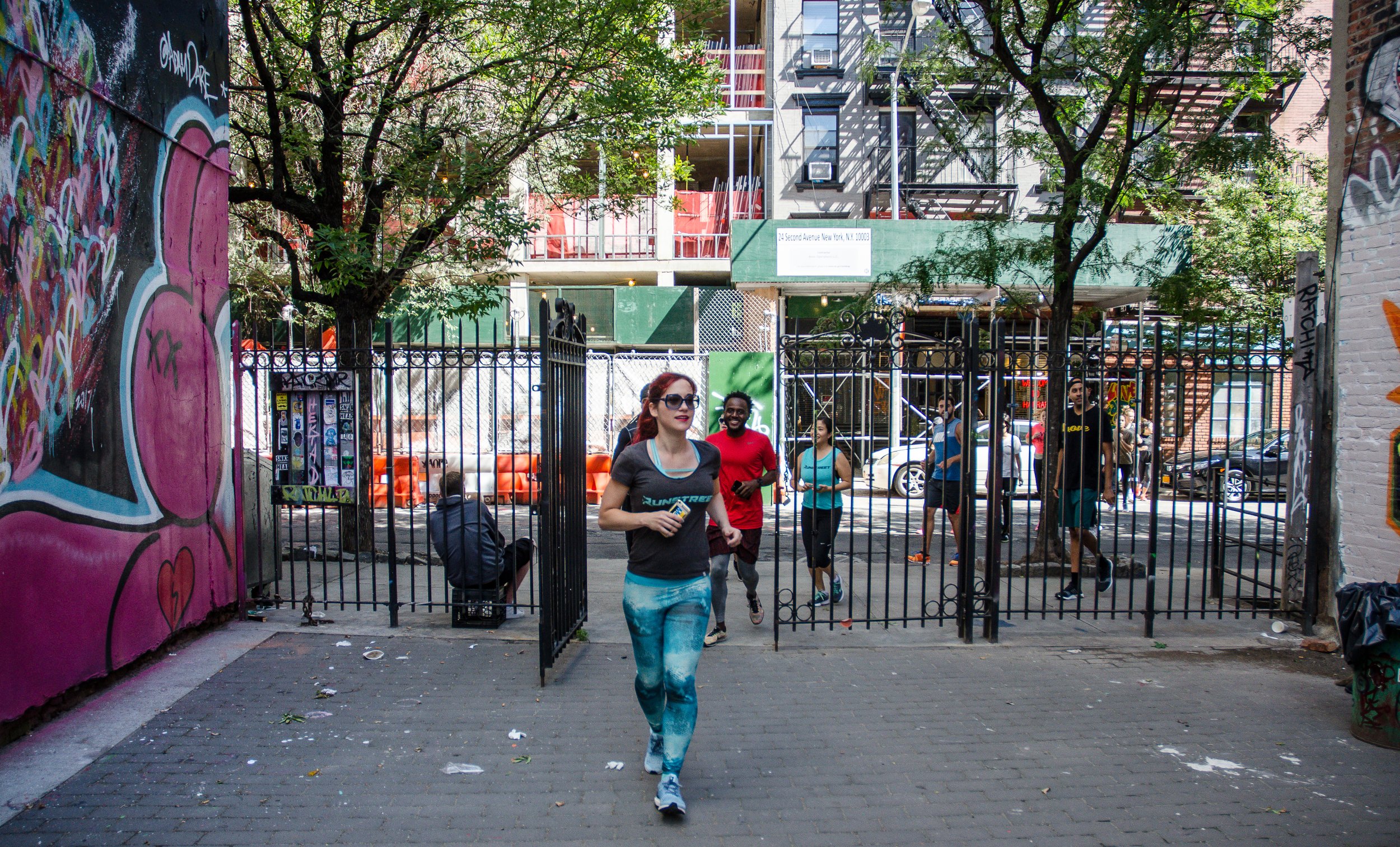The Slow Running Movement: Benefits + How to Get Started
Photos by Marques Jackson Photography.
By Marnie Kunz,
NASM-certified trainer, USATF- RRCA-certified run coach
Slow running - or back-of-the-pack running, jogging, or “sexy pace” - is a growing movement in the running world. Spearheaded by leaders such as Martinus Evans, founder of Slow AF Run Club, slow running is making room for more runners of all shapes, sizes, and paces in the running world, one step at a time. Slow running includes people of every running speed, from "non-runners" to weekend warriors and marathon runners. But what is slow running exactly, and how does it affect training and racing? This guide will offer a look at running clubs, groups, and individuals who are making big changes in the running world, creating space for more than elite runners. As a running coach and longtime runner, I decided to investigate more about running slowly, the benefits, and how to do it. Here’s the rundown:
Related Post: How to Become a Better Runner
What Is Slow Running?
Slow running is exactly what it sounds like - moving at a relaxed pace. Since pace can be subjective - one person’s jog is another’s race pace, slow running doesn’t have set numbers on what qualifies. It can be running at your base run pace, training zone 2, or slow jogging.
Martinus Evans, founder of Slow AF Run Club, defines slow running as back-of-the-pack running. His club caters to “runners and walkers at the back of the pack.” His mission is to diversify running by allowing more runners to run, jog, and walk and change the sport of running.
When he started running 11 years ago, Evans’ doctor told him he was “fat” and needed to “lose weight or die.” Despite his doctor’s doubt, Evans started running and completed a marathon. Since then, he has been slowly running his way through marathons and more than 100 races.
Evans and his online community of more than 10,000 members have been making waves in the running world. Races have added more resources for the back-of-the-pack runners, with pacers and extended finish times.
And as the average pace of runners continues to get slower, more people are finding their “sexy pace” and learning to enjoy running in itself without worrying about numbers and race times.
Related Post: Guide to Slow Living: Benefits + Tips
Benefits of Running Slow
There are some significant benefits to taking things slow. Many runners report that running slowly allows them to enjoy the run experience more without worrying about numbers and pace. Running slowly also opens up the doors for more runners, allowing people who don’t fit the traditional mold of the skinny, sinewy runner to participate in the great sport of running.
Here are some of the main benefits of slow running:
Increased enjoyment on the run. Without the burden of worrying about tracking and times, runners find they can stop and appreciate their surroundings and the overall experience of running more.
People with a broader range of abilities can participate in races and runs. Running is no longer limited to “fast people” or those with certain body types or pacing stats. A more diverse range of runners from all backgrounds can participate in the slower running movement.
Stress relief. One of the best benefits of running is the stress relief and mental boost it provides. However, some runners get caught up in worrying about their paces and times, and running becomes another source of stress. With slow running’s de-emphasis on pacing and disregard for race stats, runners can transition away from being amxious, strenuous runners to more relaxed runners.
Better health. Running slowly offers excellent cardiovascular benefits and can help maintain a healthy weight and reduce your risk of heart disease, high cholesterol, diabetes, and other health conditions. Relaxed pace running helps strengthen your muscles, bones, and joints without the higher impact of fast running and intensive pounding on pavement.
Training benefits. Following the easy-hard training principle and progressive overload, running at a relaxed pace gives your body time to recover from more intense workouts. Unless you’re a professional runner, running slowly should make up the bulk of your training, with “easy run” days being the foundation of your training. Running at a relaxed pace helps to improve your endurance and also reduces discomfort when training. If you’re training for a long-distance race such as a half marathon or marathon, you should run at a slow pace for your weekly long runs. This will help you to be able to run farther and increase your stamina.
Health benefits with less stress. Running slow places less strain on your tendons and ligaments than more intense, fast running. It helps train your muscle fibers to work for longer periods, allowing you to build your endurance.
Runstreet Art Runs are a great opportunity to appreciate running.
If you need a customized running training plan to build your endurance, I’m here to help! Head to the Runstreet Training Center for training plans for every ability and running goal.
How to Do It
With so many benefits, you may be wondering how to join this “sexy pace” running club. All you need is a good pair of running shoes, and you’re set to begin! Here are some tips to help you add slow running to your training:
Run at a relaxed pace
Run at about 40 to 50 percent effort level. If you are using a heart rate monitor for heart rate training, aim for 65-70 percent of max heart rate. If you’re running with someone, you should be able to comfortably carry on a conversation at this pace.
Build your mileage gradually
Tips to enjoy slow running.
As with all running forms, you should slowly add distance to your training program. Add no more than 10 percent to your weekly mileage to minimize your risk of injury and prevent overtraining. So if you run 5 miles the first week, for example, you can add 10 percent - or half of a mile - to your program to run 5.5 miles the following week.
Eat Well
Fueling your body is crucial to have energy on your runs. Include enough carbohydrates in your diet for running fuel. Carbs are stored in your body in the form of glycogen, which gives your muscles the power they need to perform on the run.
Related Post: What to Eat Before a Long Run - Tips from a Coach
Take rest days
All runners need rest days regardless of pace, so take at least one full rest day a week to allow your body time to recover from training.
Join a club
Check out the Slow AF Run Club for lots of social support from fellow slow runners worldwide. You can also join a local running group to get local recommendations for your training and learn about nearby events in your area.
Run with someone
Running with others adds motivation and fun to your workouts. Enlist a friend or family member to run with you for extra accountability and bonding time. You can also run with your dog if your pup enjoys running.
Take the scenic route
Running is a great way to explore new places. Add variety to your training by checking out parks, trails, and routes you haven’t run before.
Have you tried slow running? Share your runs with us by following and tagging @Runstreet on Instagram to get cheered on. If you need a training program to help you build endurance and improve your health, head to our Training Center.
Happy - and slow - running to you, enjoy! 😊
Related Posts: 15 Best Vacation Races, How to Create a Running Route: Best Apps to Try
Marnie Kunz is a NASM-certified trainer and USATF- and RRCA-certified running coach, a dog lover, an Akita mom, and the founder of Runstreet. She specializes in helping runners get faster and stronger and helping beginners elevate their fitness levels. She is based in Brooklyn, New York.





